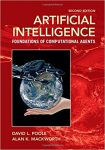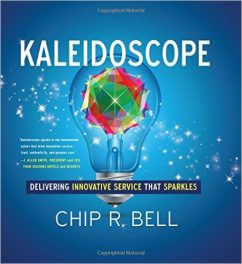 Authors: David L. Poole, and Alan K. Macworth
Authors: David L. Poole, and Alan K. Macworth
Publisher: Cambridge University Press – 792 pages
Book Review by: Sonu Chandiram
This book about the science of artificial intelligence (AI) has been developed and is written to be accessible (easily understandable) to a wide audience, and not just by those who have reached a certain level of technical proficiency in this area.
The growing field of AI holds much promise in terms of making the lives of many people more enjoyable, enabling them to make (or making for them) the right decisions that require a lot of data, as well as performing some judgmental and mechanical tasks. One of these tasks for example, is driving safely. Tests have shown that self-driving vehicles reduce accidents.
At the outset, the editors point out that the field of AI has a ‘coherent formal theory’ even as its experimental aspect is rambunctious. It is a science built on solid foundations, they point out in the Preface. However, while they present the foundations of AI, they do so in only a rough sketch form so that it is understood by as many readers as possible.
The authors define AI as “a field that studies the synthesis and analysis of computational agents that act intelligently.” They present some examples of the complexity of artificial intelligence required to build useful intelligence systems. They contend that while the systems are complex, “the foundations and the building blocks should be simple.”
We present below the titles of the five Parts and 16 chapters of this book to provide you a broad overview of the topics covered in this book:
- Agents in the World: What Are Agents and How Can They Be Built?
- Artificial Intelligence and Agents
- Agent Architectures and Hierarchical Content
- Reasoning, Planning, and Learning with Certainty
- Searching for Solutions
- Reasoning with Constraints
- Propositions and Inference
- Planning with Certainty
- Supervised Machine Learning
- Reasoning, Learning, and Acting with Uncertainty
- Reasoning with Uncertainty
- Planning with Uncertainty
- Learning with Uncertainty
- Malignant Systems
- Learning to Act
- Reasoning, Learning, and Acting with Individuals and Relations
- Individuals and Relations
- Ontologies and Knowledge-Based Systems
- Relational Planning, Learning, and Probabilistic Reasoning
- Retrospect and Prospect
- Retrospect and Prospect
- Mathematical Preliminaries and Notation
While much of the content of this book can be understood by the general audience, it has been developed to be used as an introductory text for the systematic study of artificial intelligence by advanced undergraduate and graduate students in computer science, computer engineering, and related courses/ “It will appeal more to the technically-minded,” the authors write.
Artificial intelligence is a relatively new field of study that began about 60 years ago with Stanford University being a center of research for several pioneers. It has come a long way, since then. “We now have the tools to test hypotheses about the nature of thought itself,” Poole and Macworth write in the first chapter of this book.
They quote Bruce Buchanan, a professor of computer science, medicine, and philosophy at the University of Pittsburgh, as having written in 2005: “However, only in the last half century have we, the AI community, been able to build artificial machines that test hypotheses about the mechanisms of thought and intelligent behavior and thereby demonstrate mechanisms that formerly existed as theoretical possibilities.”
While a good amount of space (Part II – Reasoning, Planning, and Learning with Certainty) is devoted to having AI machines making decisions for humans when sufficient data is available, what are the outcomes of decisions when there is insufficient data?
In Part III – Reasoning, Planning, and Learning with Uncertainty – you will find answers to this question. One of the key answers is provided right at the beginning of chapter 8, Reasoning with Uncertainty. The authors quote Pierre Simon de Laplace who wrote in 1812: “The most important questions of life are, for the most part, really only problems of probability…the theory of probabilities is at bottom nothing but common sense reduced to calculus.”
How can one assess the probabilities of getting a certain desired outcome? One sure way to increase someone’s chances of success in an endeavor is to look at past performance records. This reminds us of how Warren Buffett, the world’s greatest investor, picks stocks, From 1965 through 2016, his Berkshire Hathaway has outperformed the S&P 500 by 11.1 percent per year.
This translates to the company’s cumulative overall gain of 1,972,595 percent to the S&P 500’s mere 12,717 percent. He picks stocks that have fast growth of earnings and dividends, focusing typically on those that not only have low price-to-earnings multiples, but also growing their earnings and dividend payouts rapidly.
This book provides an extensive coverage of topics relating to artificial intelligence. It is an excellent resource well worth reading on one of the most important emerging developments in today’s world.
Authors:
David L. Poole is Professor of Computer Science at the University of British Columbia in Vancouver, Canada. He is a coauthor of three artificial intelligence books including Statistical Relational Artificial Intelligence: Logic, Probability, and Computation. He is a former Chair of the Association for Uncertainty in Artificial Intelligence, the winner of the Canadian AI Association (CAIAC) 2013 Lifetime Achievement Award and a Fellow of the Association for the Advancement of Artificial Intelligence.
Alan K. Macworth is Professor of Computer Science at the University of British Columbia in Vancouver, Canada. He has authored over 130 papers and coauthored two books: Computational Intelligence: A Logical Approach, and Artificial Intelligence: Foundations of Computational Agents. His awards include the AIJ Classic Paper Award and the ACP Award for Research Excellence. He has served as president IJCAI, AAAI, CAIAC. He is a Fellow of AAAI, CAIAC, and the Royal Society of Canada.






